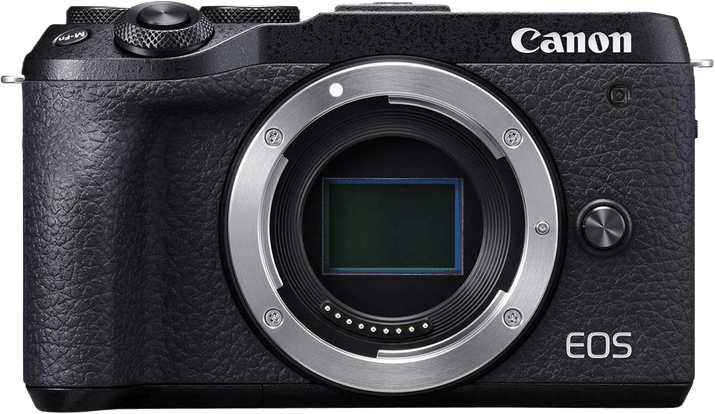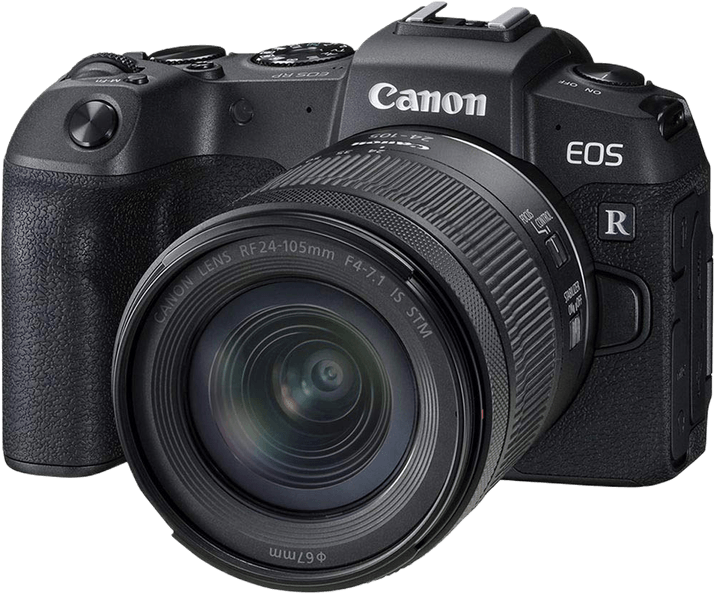Canon EOS M6 Mark II vs EOS RP Comparison
Canon EOS M6 Mark II

Canon EOS RP

The Canon EOS RP edges out the Canon EOS M6 Mark II with a score of 65/100 compared to 63/100. Both cameras share similarities as mirrorless models released in 2019, with the RP having a higher launch price of $1300 compared to the M6 Mark II’s $850. The RP is slightly larger and heavier, measuring 133 x 85 x 70mm and weighing 440g, while the M6 Mark II measures 120 x 70 x 49mm and weighs 408g.
The EOS RP’s higher score signifies a better camera, likely due to its features and performance. However, the M6 Mark II does have some advantages, such as its lower price and lighter weight, making it a more affordable and portable option for certain users. When considering which camera to purchase, it’s essential to weigh these factors and decide which aspects are more important for your specific needs.
Canon EOS M6 Mark II vs EOS RP Overview and Optics
The Canon EOS RP outperforms the Canon EOS M6 Mark II in optics, scoring 67/100 compared to the M6’s 62/100. Both cameras share some common specifications, such as CMOS sensor type, Digic 8 processor, and the lack of image stabilization. However, there are distinct differences that set them apart and contribute to the RP’s higher score.
The Canon EOS RP has a full-frame sensor, while the M6 Mark II has an APS-C sensor. This difference means that the RP can capture more light and produce better image quality, especially in low-light conditions. Additionally, the RP’s sensor has a higher DXOMARK score of 85, compared to the M6’s 58, further solidifying its superiority in image quality.
Despite having a lower megapixel count (26MP) compared to the M6 Mark II (33MP), the RP’s full-frame sensor allows it to produce higher-quality images. The larger sensor compensates for the lower megapixel count, making it a better choice for those seeking superior image quality.
On the other hand, the M6 Mark II has a faster shooting speed of 14 frames per second, compared to the RP’s 5 frames per second. This advantage makes the M6 Mark II more suitable for capturing fast-moving subjects and action photography.
The Canon EOS RP’s full-frame sensor, higher DXOMARK score, and better overall image quality make it the clear winner in optics. However, the M6 Mark II’s faster shooting speed may be preferable for certain photography styles. Ultimately, the choice between these two cameras depends on the individual’s priority: image quality or shooting speed.
Canon EOS M6 Mark II vs EOS RP Video Performance
The Canon EOS M6 Mark II outperforms the Canon EOS RP in video capabilities with a score of 91/100, while the EOS RP scores 70/100. Both cameras share common specifications, such as a maximum video resolution of 4K and dimensions of 3840 x 2160. Additionally, both cameras have built-in time-lapse functionality.
The EOS M6 Mark II surpasses the EOS RP due to its higher maximum video frame rate of 120fps, which is significantly more than the EOS RP’s 25fps. This higher frame rate allows for smoother and more detailed video capture, especially during fast-paced action or slow-motion footage. This advantage makes the EOS M6 Mark II the better choice for videographers who require high-quality footage with versatility in frame rates.
In contrast, the EOS RP has no specific advantages over the EOS M6 Mark II in terms of video capabilities. Its lower frame rate of 25fps may be suitable for casual videographers and photographers who do not prioritize video performance. However, when comparing the two cameras solely on video capabilities, the EOS RP falls short of the EOS M6 Mark II.
Considering the difference in video scores and the superior frame rate of the EOS M6 Mark II, it is evident that this camera is the better option for those focused on video performance. The EOS RP may still be a viable option for photographers who do not prioritize high-quality video capture, but for those seeking the best video capabilities, the EOS M6 Mark II is the clear winner.
Canon EOS M6 Mark II vs EOS RP Features and Benefits
The Canon EOS M6 Mark II and the Canon EOS RP both have a feature score of 70 out of 100. These cameras share several specifications, including a 3-inch screen size, screen resolution of 1,040,000 dots, touchscreen capability, flip screen, and lack of GPS. Additionally, both cameras have Wi-Fi and Bluetooth connectivity.
The Canon EOS M6 Mark II excels in its compact and lightweight design, making it more portable and convenient for travel and everyday use. This advantage allows photographers to carry the camera with ease and capture high-quality images on the go.
On the other hand, the Canon EOS RP has the advantage of being a full-frame camera, offering better image quality and low-light performance. This feature is crucial for professional photographers and those looking to capture stunning images in various lighting conditions.
In terms of shared features, both cameras have user-friendly touchscreen interfaces and flip screens, making them versatile and easy to use for a range of photography styles. The absence of GPS in both cameras may be a drawback for some users, but the inclusion of Wi-Fi and Bluetooth connectivity allows for seamless sharing and remote control of the cameras.
Considering these points, the Canon EOS M6 Mark II is the better option for those seeking a compact and lightweight camera, while the Canon EOS RP is more suitable for photographers prioritizing image quality and low-light performance. Despite their differences, both cameras offer a range of useful features, making them solid choices for various photography needs.
Canon EOS M6 Mark II vs EOS RP Storage and Battery
The Canon EOS M6 Mark II outperforms the Canon EOS RP in storage and battery with a score of 35/100, compared to the RP’s 29/100. Both cameras have one memory card slot, accepting SD, SDHC, and SDXC cards (UHS-II compatible), and use the same LP-E17 battery type. Additionally, both cameras offer USB charging capabilities.
The M6 Mark II excels with a longer battery life, providing 305 shots per charge, while the RP only delivers 250 shots. This advantage makes the M6 Mark II more suitable for extended shooting sessions without needing to swap out or recharge batteries.
However, the EOS RP does not offer any distinct advantages over the M6 Mark II in terms of storage and battery.
Considering the longer battery life and identical storage options, the Canon EOS M6 Mark II proves to be the superior choice in this category.
Canon EOS M6 Mark II vs EOS RP – Our Verdict
Are you still undecided about which camera is right for you? Have a look at these popular comparisons that feature the Canon EOS M6 Mark II or the Canon EOS RP:

